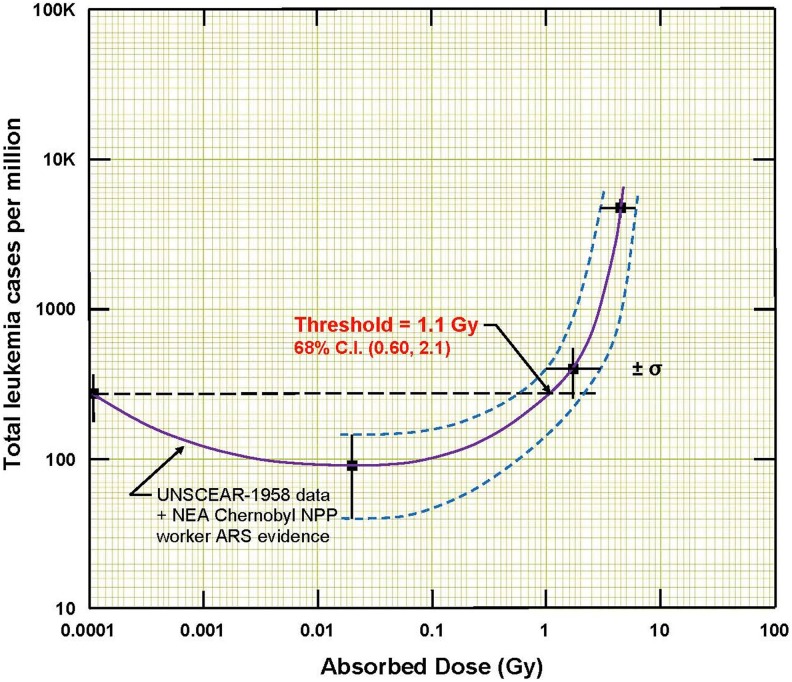Publication of the human evidence of a threshold dose for acute, radiation-induced leukemia1 has led to discussion and criticism about the use of LNT-based units of dose (rem and sievert), which are surrogates for risk,2 instead of the absorbed dose unit gray (1 Gy = 1 J/kg), which is independent of the type of radiation . Since the United Nations Scientific Committee on the Effects of Atomic Radiation (UNSCEAR) 1958 report3 gives dose in rem, Figure 2 in the study by Cuttler1 indicates dose in the same units. A question about the uncertainty of the threshold dose reported was also raised. This letter addresses these 2 issues and presents evidence for the more accurate threshold dose: 1.1 Gy, 68% confidence interval (CI: 0.60-2.1).
In the study by Heyssel et al, Figure 3 shows that the neutron dose in Zone D, 2000 to 2999 m from ground zero, is an order of magnitude or more lower than the gamma dose.4 Therefore, the dose that Hiroshima atomic bomb survivors in Zone D received may be changed from 2 rem to 2 rad or 0.02 Gy.
For Zone C, Cuttler’s study1 assigned a dose of 1 Sv (100 rem) instead of 0.5 Sv (50 rem) to address the footnote in the UNSCEAR 1958 report3 (p165) stating, “Almost all cases of leukemia in this zone occurred in patients who had severe radiation complaints, indicating that their doses were greater than 50 rem.” However, a more accurate assignment of dose may be made using human evidence in the OECD Nuclear Energy Agency (NEA) report on the radiological and health impact of the 1986 Chernobyl NPP accident5 in which many workers suffered acute radiation syndrome.
The following statements appear in Chapter IV of this report:
All of the dosimeters worn by the workers were overexposed and did not allow an estimate of the doses received. However, information is available on the doses received by the 237 persons who were placed in hospitals and diagnosed as suffering from acute radiation syndrome. Using biological dosimetry, it was estimated that 140 of these patients received whole-body doses from external irradiation in the range 1-2 Gy, that 55 received doses between 2 and 4 Gy, that 21 received between 4 and 6 Gy, and that the remaining 21 received doses between 6 and 16 Gy.5 (p32)
Based on this Chernobyl evidence, a better dose assignment for the survivors in Zone C is 1 to 3 Gy, with a 1.7 Gy geometric mean. For Zones A and B, a better method of estimating the threshold is to “pool” or combine the data (shown in Cuttler, 2018 [Table 1]). Of the 237 Chernobyl workers, 28 died within weeks. Table 6 on page 38 of the NEA report5 indicates that 20 received estimated doses in the range 6 to 16 Gy; 7 in the range 4 to 6 Gy, and 1 in the range 2 to 4 Gy. Based on this information, the dose assignment should be 3 to 6 Gy, with a 4.5 Gy mean and the combined leukemia cases per million is 106 × (15 + 33)/(1241 + 8810) = 4776 ± 689. (Note that the UNSCEAR 1958 report used 1 σ error) Figure 1 shows the number of leukemia cases versus radiation dose in units of Gy. The threshold dose for onset of radiogenic leukemia using this method is about 1.1 Gy, with 68% CI (0.60-2.1).
Figure 1.
Total number of radiation-induced leukemia cases per million versus absorbed radiation dose for the Hiroshima atomic bomb survivors. Evidence of a threshold is apparent at 1.1 Gy, CI: 0.60-2.1. (CI indicates confidence interval) The incidence of radiogenic leukemia is only 0.5% of the survivors who were in the high radiation zones.
The dose to initiate leukemia (cancer of blood-forming tissues) is high, and the incidence is only 0.5% of the survivors in the high radiation zones A and B, which is very surprising.
References
- 1. Cuttler JM. Evidence of a dose threshold for radiation-induced leukemia. Dose-Response. 2018;16(4):1559325818811537 https://www.ncbi.nlm.nih.gov/pmc/articles/PMC6247492/ (accessed 14 December 2018). [DOI] [PMC free article] [PubMed] [Google Scholar]
- 2. Mitchel RE. Cancer and low dose responses in vivo: implications for radiation protection. Dose-Response. 2007;5(4):284–291. https://www.ncbi.nlm.nih.gov/pmc/articles/PMC2477713/ (accessed 14 December 2018). [DOI] [PMC free article] [PubMed] [Google Scholar]
- 3. United Nations Scientific Committee on the Effects of Atomic Radiation. Report to the General Assembly. New York, NY: United Nations; 1958. Annex G, p 165 Table VII. [Google Scholar]
- 4. Heyssel R, Bertrand Brill A, Woodbury LA, et al. Leukemia in Hiroshima atomic bomb survivors. Blood. 1960;15(3):313–331. [PubMed] [Google Scholar]
- 5. Waight P, Métivier H, Jacob1 P, et al. Chernobyl ten years on: radiological and health impact. OECD Nuclear Energy Agency. 1995. https://www.oecd-nea.org/rp/chernobyl/chernobyl-1995.pdf (accessed 14 December 2018).



